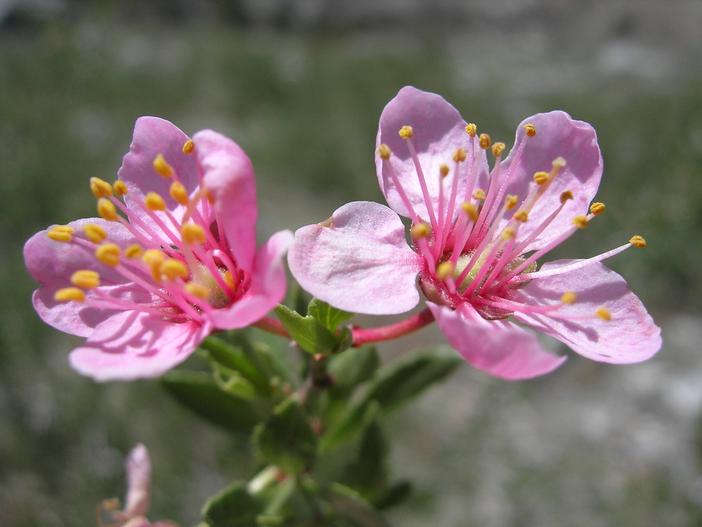Desert Peach
(Prunus andersonii)
Desert Peach (Prunus andersonii)
/
/

Joe Decruyenaere
CC BY-SA 2.0
Image By:
Joe Decruyenaere
Recorded By:
Copyright:
CC BY-SA 2.0
Copyright Notice:
Photo by: Joe Decruyenaere | License Type: CC BY-SA 2.0 | License URL: https://creativecommons.org/licenses/by-sa/2.0/ | Uploader: joedecruyenaere | Publisher: Flickr





































































Estimated Native Range
Summary
Prunus andersonii, commonly known as Desert Peach, is a deciduous shrub native to the chaparral and desert scrub of the Great Basin in the western United States, particularly in California and Nevada. It typically grows to about 2 meters (80 inches) in height, with tangled branches ending in spiny-tipped twigs. The leaves are serrated, lance-shaped to oval, and grow in clusters, each measuring up to 3 centimeters (1+1⁄4 inches) long. The plant is notable for its solitary or paired flowers, each with five concave pink petals just under 1 cm (3⁄8 inch) long, and numerous whisker-like stamens at the center. The flowers are quite showy and bloom before or as the leaves emerge. The fruit is a fuzzy reddish-orange drupe about 1 cm (3⁄8 inch) wide, which can be fleshy in wet years and dry during drought. The seed within the fruit is heart-shaped.
Desert Peach is valued for its drought tolerance and ability to thrive in arid conditions, making it suitable for xeriscaping and naturalistic plantings in dry regions. Its showy pink flowers and attractive foliage also make it a desirable ornamental shrub for water-conserving gardens. It requires full sun exposure and well-drained soils, preferably with low to moderate fertility. While it is low-maintenance, it can spread aggressively via rhizomes, forming large clonal colonies. Care should be taken to manage its spread in garden settings.CC BY-SA 4.0
Desert Peach is valued for its drought tolerance and ability to thrive in arid conditions, making it suitable for xeriscaping and naturalistic plantings in dry regions. Its showy pink flowers and attractive foliage also make it a desirable ornamental shrub for water-conserving gardens. It requires full sun exposure and well-drained soils, preferably with low to moderate fertility. While it is low-maintenance, it can spread aggressively via rhizomes, forming large clonal colonies. Care should be taken to manage its spread in garden settings.CC BY-SA 4.0
Plant Description
- Plant Type: Shrub
- Height: 3-6 feet
- Width: 3-6 feet
- Growth Rate: Moderate
- Flower Color: Pink
- Flowering Season: Spring
- Leaf Retention: Deciduous
Growth Requirements
- Sun: Full Sun
- Water: Low
- Drainage: Medium, Fast
Common Uses
Bee Garden, Bird Garden, Butterfly Garden, Edible*Disclaimer: Easyscape's listed plant edibility is for informational use. Always verify the safety and proper identification of any plant before consumption., Fragrant, Low Maintenance, Rabbit Resistant, Showy Flowers
Natural Habitat
Chaparral and desert scrub of the Great Basin
Other Names
Common Names: Desert Almond, Anderson’s Peachbrush
Scientific Names: , Prunus andersonii, Amygdalus andersonii, Emplectocladus andersonii,
GBIF Accepted Name: Prunus andersonii Gray